A future history is a postulated history of the future and is used by authors of science fiction and other speculative fiction to construct a common background for fiction. Sometimes the author publishes a timeline of events in the history, while other times the reader can reconstruct the order of the stories from information provided therein.

Stephen Baxter is an English hard science fiction author. He has degrees in mathematics and engineering.
The Galactic Empire series is a science fiction sequence of three of Isaac Asimov's earliest novels, and extended by one short story. They are connected by their early place in his published works and chronological placement within his overarching Foundation universe, set around the rise of Asimov's Galactic Empire, between the Robot and Foundation series to which they were linked in Asimov's later novels.

The Three Laws of Robotics are a set of rules devised by science fiction author Isaac Asimov. The rules were introduced in his 1942 short story "Runaround", although they had been foreshadowed in some earlier stories. The Three Laws, quoted from the "Handbook of Robotics, 56th Edition, 2058 A.D.", are:
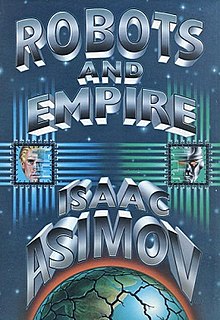
Robots and Empire is a science fiction novel by the American author Isaac Asimov, published by Doubleday Books in 1985. It is part of Asimov's Robot series, which consists of many short stories and five novels.
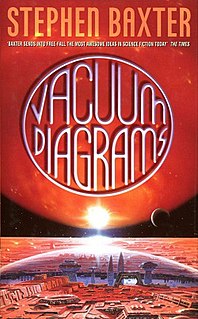
Vacuum Diagrams is a collection of science fiction short stories by British writer Stephen Baxter. The collection connects the novels of the Xeelee Sequence and also shows the history of mankind in the Xeelee universe, and ultimately the universe. While each short story in the collection is self-contained, the stories are presented as being contained in the context of the first story, "Eve", about a man who is forced to witness the events in the short stories by a god-like being. "Eve" acts as a structure for the short stories, with an introduction at the beginning of Vacuum Diagrams, short scenes occurring between each "era", and an ending that wraps up the plot for the "Eve" story itself. Vacuum Diagrams won the Philip K. Dick Award in 1999.
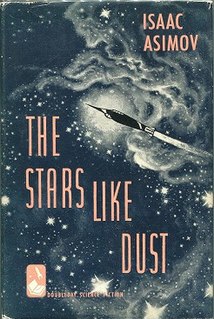
The Stars, Like Dust is a 1951 science fiction mystery book by American writer Isaac Asimov.
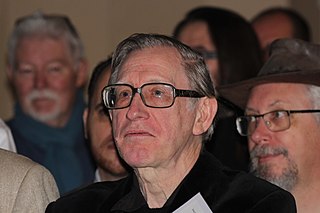
Brian Michael Stableford is a British science fiction writer who has published more than 70 novels. His earlier books were published under the name Brian M. Stableford, but more recent ones have dropped the middle initial and appeared under the name Brian Stableford. He has also used the pseudonym Brian Craig for a couple of very early works, and again for a few more recent works. The pseudonym derives from the first names of himself and of a school friend from the 1960s, Craig A. Mackintosh, with whom he jointly published some very early work.

The Martian Way is a science fiction novella by American writer Isaac Asimov. It was first published in the November 1952 issue of Galaxy Science Fiction and reprinted in the collections The Martian Way and Other Stories (1955), The Best of Isaac Asimov (1973), and Robot Dreams (1986). It was also included in The Science Fiction Hall of Fame, Volume Two (1973) after being voted one of the best novellas up to 1965.

Timelike Infinity is a 1992 science fiction book by British author Stephen Baxter. The second book in the Xeelee Sequence, Timelike Infinity introduces a universe of powerful alien species and technologies that manages to maintain a realistic edge because of Baxter's physics background. It largely sets the stage for the magnum opus of the Xeelee Sequence, Ring.

Exultant is a science fiction novel by British author Stephen Baxter. It is part two of the Destiny's Children series. The book was published by Victor Gollancz Ltd in September 2004.

Ring is a 1994 science fiction novel by British author Stephen Baxter. The novel tells the story of the end of the universe and the saving of mankind from its destruction. Two parallel plots are followed throughout the novel: that of Lieserl, an AI exploring the interior of the sun, and that of the Great Northern, a generation ship on a five-million-year journey.

Flux is a 1993 science fiction novel by British author Stephen Baxter. It is the third book in Baxter's Xeelee Sequence.
"Cygnus X-1" is a two-part song series by Canadian progressive rock band Rush. The first part, "Book I: The Voyage", is the last song on the 1977 album A Farewell to Kings, and the second part, "Book II: Hemispheres", is the first song on the following album, 1978's Hemispheres. Book I is ten minutes and twenty-five seconds long (10:25), and Book II is eighteen minutes and seven seconds (18:07).
The Xeelee Sequence is a series of hard science fiction space opera novels, novellas, and short stories written by British science fiction author Stephen Baxter. The series spans billions of years of fictional history, centering on humanity's future expansion into the universe, its intergalactic war with an enigmatic and supremely powerful Kardashev Type IV alien civilization called the Xeelee, and the Xeelee's own cosmos-spanning war with dark matter entities called Photino Birds. The series features many other species and civilizations that play a prominent role, including the Squeem, the Qax, and the Silver Ghosts. Several stories in the Sequence also deal with humans and posthumans living in extreme conditions, such as at the heart of a neutron star (Flux), in a separate universe with considerably stronger gravity (Raft), and within eusocial hive societies (Coalescent).

Question and Answer is a science fiction novel by American writer Poul Anderson. It originally appeared in the June and July 1954 issues of magazine Astounding Science Fiction, and was later reprinted in 1956 as part of Ace Double D-199 under the title Planet of No Return, and again as a stand-alone Ace novel in February 1978 under the original title.
The planetary systems of stars other than the Sun and the Solar System are a staple element in many works of the science fiction genre.
Chris Beckett is a British social worker, university lecturer, and science fiction author. He has written several textbooks, dozens of short stories, and six novels.
This is a list of the published works of Aliette de Bodard.
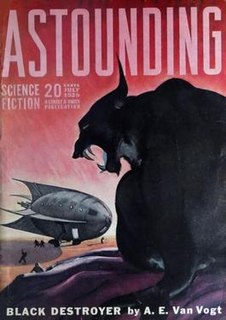
"Black Destroyer" is a science fiction short story by Canadian-American writer A. E. van Vogt, first published in Astounding SF in July 1939. It has been marked as the story that represents the start of the Golden Age of Science Fiction.













